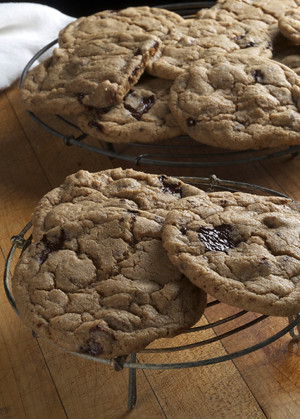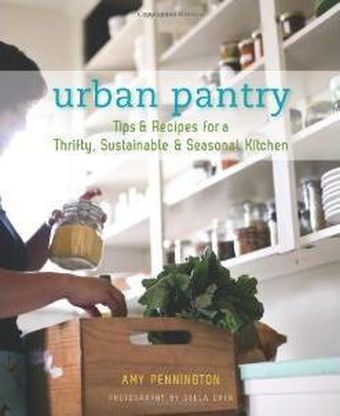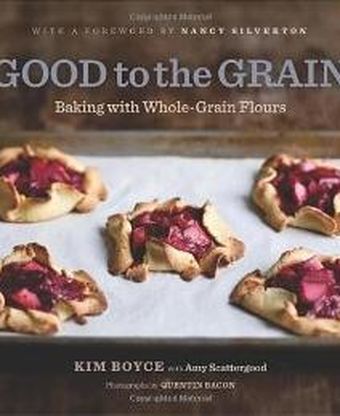Good to the Grain, by Kim Boyce with Amy Scattergood, is an impressive looking book. Published by a company specializing in four-color productions, it’s big and heavy, gorgeously designed, and beautifully photographed by Quentin Bacon. Are we to judge a book by its cover? And weight? The glossiness of its pages? Can we compare it to the light bendable upstart, Urban Pantry, by Seattle entrepreneur, foodie, gardener, writer Amy Pennington?
What makes a cookbook excellent?
I was excited to receive Good to the Grain because I’d been working with various grains for a bread app that’s in the works -- which is why I had Buckwheat on hand. The book is organized by flour types,12 of them, with a final chapter on jams and compotes. The recipe for buckwheat-and-pear pancakes was an easy first choice, given there was a sleepover here and four hungry guinea pigs. My son James shook his head and went back to the plain pancakes (which I made because I don’t know any 11-year-olds who prefer whole grain to bland white starch). But Tim, age 12, gave these babies a big thumbs up. As did I -- they were substantial and still light, moist and flavorful. Love the honey-and-butter replacement for syrup as well, a cool all-purpose idea.
I stayed with buckwheat for my first Urban Pantry recipe, in the form of soba noodles with peanut sauce, which were excellent. A simple tasty dish, and the peanut sauce is a solid staple recipe for more than just soba.
I loved that Pennington featured preserved lemon in several dishes; it's a great pantry staple, easy to cure at home and a powerful seasoning. I tried it in her spicy chickpeas in tomato. I admired the use of chickpeas in a non-falafel, non-hummus preparation. And I liked its big spices, although I questioned adding the allspice berries and cloves to the cooking pot whole; I didn’t want to crunch into one of them so I put mine in cheesecloth and removed them at the end.
The final Urban Pantry dish I tried was an excellent milk-braised pork shoulder seasoned with garlic and sage. Easy, solid, flavorful (though her inclusion of the picked sage stems seems unnecessary).
But Pennington truly endeared herself to me with a preparation I couldn’t manage, because I didn’t have the three weeks the recipe calls for: Fizzy Ginger Soda, a drink made from naturally fermented ginger. I love putting microbes to work in the service of flavor and especially look forward to trying this recipe. (What makes a great cookbook? I’ve seen buckwheat pancakes and milk-braised pork shoulder, but introducing me to a new technique or new preparation such as this soda is one such quality.)
Returning to the fancy pants Good To the Grain, I wondered how well would it work with the staples, the basics. That to me is a better test than a chi-chi pancake. I made an oat-and-whole-wheat sandwich bread, flavored with molasses. It baked up soft and moist, somewhat dense, as expected, but also light -- a very satisfying whole grain bread, and one I wouldn’t hesitate to make again.
But the real test was a whole wheat chocolate chip cookie. Boyce’s dough uses 100% whole wheat, something I consider daring in any preparation. Whole wheat needs a little balance from white flour (the above oatmeal bread used oats, whole wheat and bread flour).
Or so I thought: these cookies were delicious and satisfying. More importantly, my 11-year-old loved them. Parents? This should be your go-to chocolate chip cookie recipe.
With one caveat: they were over-salted. Salt and chocolate are a good pair, but I don’t want to taste the salt in a chocolate chip cookie. I knew exactly what the problem was when I returned to the recipe. Kim Boyce, a former pastry chef at Spago and Campanille in California, likely uses Diamond Crystal salt (the common choice of chefs). The only kosher salt available to me is Morton. The thing is, Diamond Crystal is lighter than Morton by more than thirty percent. This means that when I added the 1 1/2 teaspoons of my Morton kosher salt, it was like adding two teaspoons of her Diamond Crystal. That proved to be half a teaspoon too much; my daughter bit into one, winced and said, “Why are they salty?” (I later confirmed by email that Diamond Crystal was the salt they used.)

photo by Donna Turner Ruhlman
These are two very different books. Are they comparable? No. How can we judge, then? Here’s how:
VERDICT
Good to the Grain
Good to the Grain is beautifully written, thanks to the superb Amy Scattergood, whose work I’ve long admired. The recipes are solid (barring the salt issue, which is more a problem with publishers than with Chef Boyce, who probably uses weights herself rather than the volume measurements publishers insist on) -- they’re clear, smart, interesting and tasty with accurate yields.
What’s most important to me though, most important by far, is that an excellent cookbook offers something that hasn’t already been published. There are other whole grain cookbooks out there, but this one’s flour-by-flour approach I found original and especially timely, as more and more cooks want to use whole grains such as amaranth and kamut. And more and more farmers are growing specialty grains.
Urban Pantry is well-written, but it doesn’t come close to the felicity Scattergood manages. Its recipes are fine, if a little on the simple side. But the bottom line for me really comes down to whether or not a book is saying something new. This is not.
This is one of the main criteria for me, personally, when deciding on what book I will write and what book idea I will reject. Is it offering something new? This is also something an agent will be asking, and if you want to write a cookbook of your own, you’ll need to be able to pinpoint what that something new is. If I can’t say what it is, I know I don’t have a book.
Judging these books had another impact on me personally. I almost never cook from recipes anymore. I had to here. And I was grateful for the intelligence, prose, organization and clarity in the recipes in Good To the Grain. It enhanced my appreciation for the work that goes into publishing a lavish book.
Lavish should never be the point, however. Lavish without substance is a book that gets opened once, then shelved forever. If you ignored the exquisite photography and the deft prose of Good To the Grain, ignored its glossy pages and the sheer exciting heft of a beautiful new cookbook, Good To the Grain would still be superb.
It just happens to be published really well, too.



2 Comments